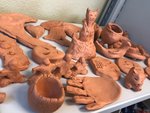
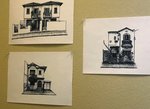
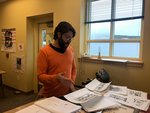

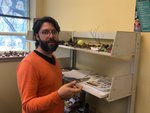
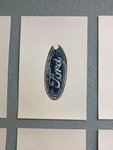
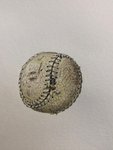
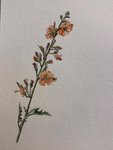
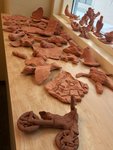
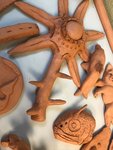




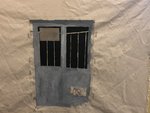
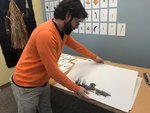

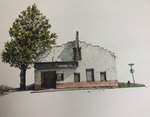


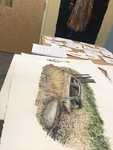
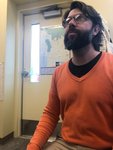
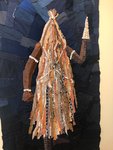
From João Galera: This is my quote based on some studies that I made about "The Waste Land", by T.S. Eliot. I read some articles and studies about this poem and the theme of memory and desire, then I create this quote.
It means that every memory is something that we create from our past and in this creation we add a lot of desire (our beliefs and things that we want to). Because of that, a memory is also a reconstruction.
Memory and desire also represent past and future:
Memory - what did we do?
Desire - what do we want?
As artist in residence for Western New Mexico University, João Galera has come to New Mexico from Brazil to create an art project of significant proportions.
“The idea is to work with the community and participate in some festivals and also in some classes,” Galera said. “I took some photography classes and some clay classes, and I also made an artist talk for the students.”
He also creates art in the little studio provided him on campus or at home.
In an exhibit at Light Art Space in Silver City, Galera’s previous work, done in San Paulo, Brazil, can be seen through March 7. An astonishing collection of drawings, serigraphy and textiles hangs in the gallery, displaying his highly detailed style and a passion for a particular mix of realism blended with symbolism. Most of the images are black-and-white, pen-and-ink pieces starkly portraying moderate city home buildings of San Paulo.
“The idea was to capture the images, because they are destroying these buildings,” he said. “The project was to keep the images of the houses. I call it ‘Before it Ends.’”
Before he left San Paulo, Galero’s project had a large exhibition and became a book. Both book and drawings sold well there. His talent was put to excellent use as the work touched the hearts of his fellow Brazilians. The destruction of the buildings of the neighborhoods has caused a lot of controversy and the art is there to promote conversation about what the people want in their city.
“It was a very, very good project, because a lot of people are disgusted about this,” he said. “They were very middle-class houses and they are building apartments and parking lots for rich people, so they are changing a lot how the town was before the city and skyscrapers arrived.”
Galero said he doesn’t know which buildings are destroyed and which are not. The project started because he lived in the neighborhood and would go for walks and take photographs of the houses.
“I don’t think the project saved buildings, but the conversations made a difference,” he said. “I could go to different places and talk about this memory and discuss if we should or we shouldn’t preserve it. Do we want a city that is vertical? Do we want a city that is history? So that is on us.”
Now, Galero has brought his fascination with -- and questions about -- the progress of old-to-new to Grant County in a new quest and some of the same kinds of questions.
Structuring his work here on the T.S. Eliot poem “The Waste Land,” Galero is describing the area around him in three parts with his art. One of the parts is about the land. On one wall of the studio, small drawings are building up one by one as the artist makes specific images of objects found around the city and the county. Here is a plant, globe mallow, and here is a cracked Ford insignia fallen off a vehicle – a ball, a tooth and so on. When finished, he will have 100 drawings of found objects, which he will crochet together like a “drawing quilt” describing the land of Grant County and Silver City.
The quilt will be presented to WNMU and will be part of his final exhibit, which will take place in May.
The second part of the project is about the people, and he is encouraging everyone in the area to participate in a community art installation.
“I am inviting people to make an object of clay that is important to each one,” he said. “At the end, we want to put all these pieces together and make just one person.”
To that end, Galero has been visiting schools, churches, museums, festivals and the farmers’ market to take the project to the community. The goal is to put all different kinds of people together with the piece. He would like anyone interested in participating in this project to contact him at his email, joaogalera@gmail.com.
Even before becoming a working artist, Galero had a strong interest in people. After getting an agricultural engineering degree, then a master’s in anthropology, he was pursuing his doctorate in anthropology in Mexico City and drawing subjects in the community where he was studying the agriculture of an indigenous community in the state of Michoacán.
An advisor he was working under was impressed by the drawings, and together they set up an exhibition.
“My life changed,” he said. “I made three exhibitions in Mexico, and then I was invited to paint a mural there, and when I was painting a mural, they were paying me. Then I thought maybe I could be a real artist who is paid for my work.”
He moved to San Paulo and started to share his art, hang out with other artists, went into the art market and sold his drawings and painting. One day he hopes to finish his doctoral program by bringing the story of the people in the town, their agricultural practices and his drawings together in a book.
The third part of the year-long Grant County project is made up of large drawings, watercolored, tying history and memory together by working with some of the abandoned places of Grant County.
Stark and beautiful images, mostly out of the mining district, appear under Galero’s pens and brushes. The old hotel in Santa Clara, the clubhouse near the Empire Zinc mine -- both before and after it burned down -- and the old theater all come back to life in these works.
“We are trying to talk about what we had, and what do we want with these,” he said “Do we want to keep it or not? What do we want to be as a society? Do you want to transform it or destroy and rebuild?”
In June, Galero will return to Brazil.
“In Brazil, we have a very different reality,” he said. “I came from San Paulo – a huge town – to a very small community. It’s very interesting, because I can see different things that I wasn’t seeing in my country. I think I have this possibility to look at different things that the people here don’t realize, because they have been here for a long time.”
In “The Waste Land” Galero said Eliot wrote a very long poem and then started to cut it down to a point where only half of what was written was left at the end. Galero said he tries to do the same thing in his drawings.
“I try to take elements and leave only what’s necessary,” he said.
Galero’s quilt about the land, his drawings and the community project will be on display during the May show at the McCray Art Gallery at WNMU kicking off on Thursday, May 7, with a lecture at 6:30 p.m. at Parotti Hall and a reception at 7:30 p.m. at the gallery.
Other items that may interest you
